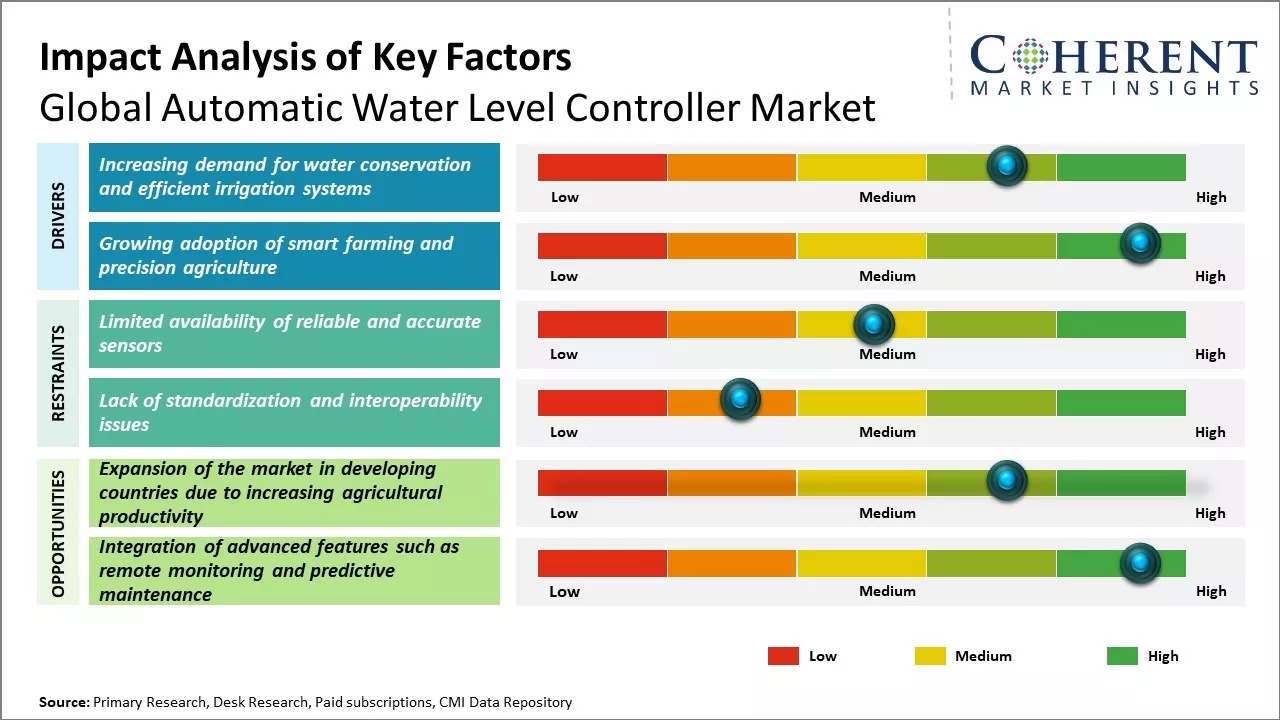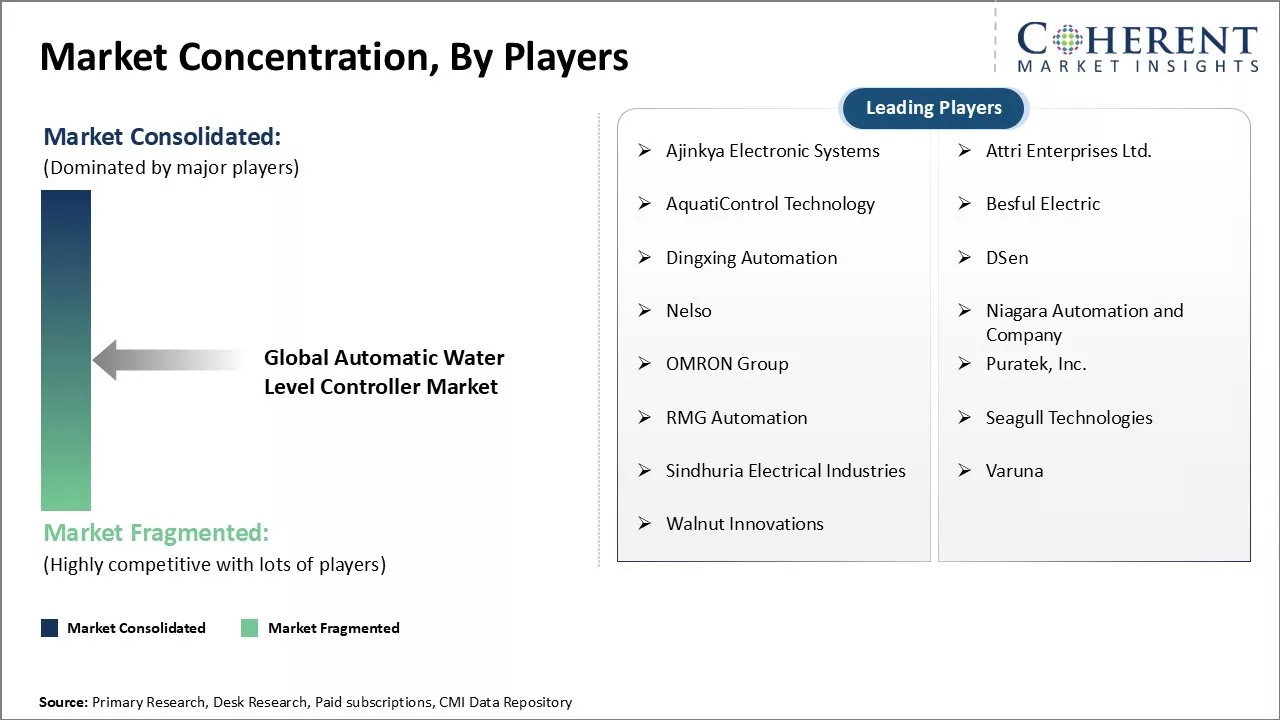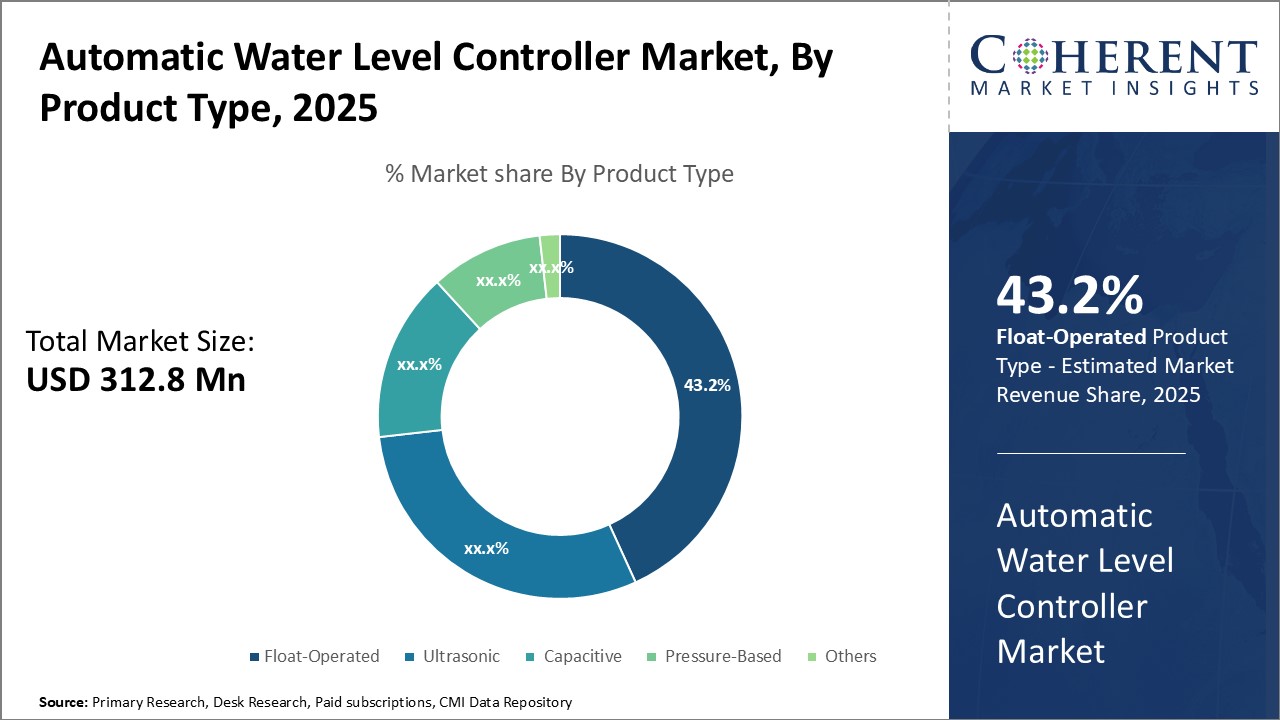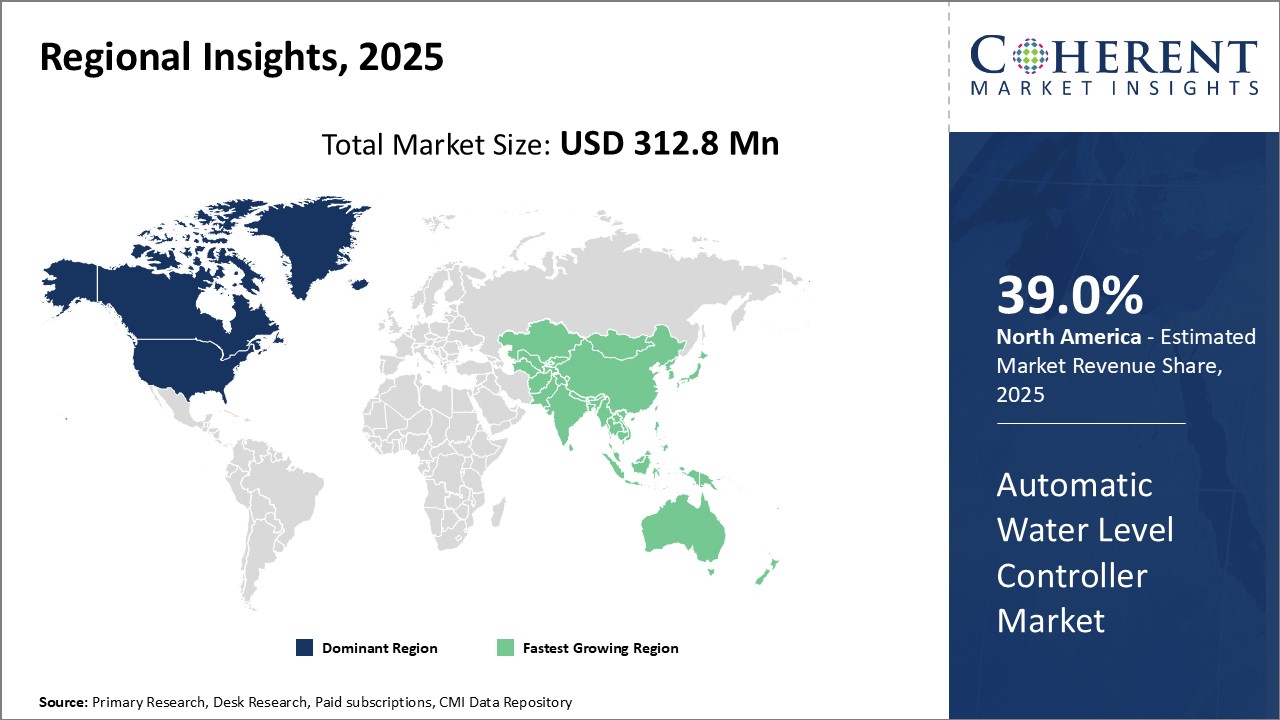Automatic Water Level Controller Market Size and Trends
Global Automatic Water Level Controller Market is estimated to be valued at USD 312.8 million in 2025 and is expected to reach USD 443.4 million by 2032, exhibiting a compound annual growth rate (CAGR) of 5.1% from 2025 to 2032.

Discover market dynamics shaping the industry: Download Free Sample
With growing industrialization and urbanization, the demand for automatic water level controllers is increasing across various end-use industries like manufacturing, oil & gas, and others. These controllers offer advantages like accurate level measurement, continuous level monitoring, and automation of water level control operations. Also, technological advancements like the development of smart controllers with remote monitoring capabilities and integration of IoT are expanding the scope of automation in various industrial processes. Rising focus on achieving operational efficiency and minimizing costs through automation is further expected to drive the demand for automatic water level controllers.
Market Driver - Increasing demand for water conservation and efficient irrigation systems
With the growing scarcity of freshwater resources, increasing concerns around sustainable water usage have come to the forefront. As populations and crop yields rise to meet rising food demand, pressure on available water resources has increased exponentially. Traditional flood and furrow irrigation methods utilize water very inefficiently, with losses as high as 50-90% of the total quantity used.
Automatic water level controllers help optimize water usage in agricultural irrigation through precision water management and control. Installed in borewells, tanks, or reservoirs, these devices automatically switch on or shut off pumps or valves when the water surface reaches pre-set high or low levels. This ensures water is supplied only as needed by the crops and prevents over-watering. The precise control of water distribution helps conserve water supplies while meeting the irrigation requirements. For farmers with limited access to adequate water, such controllers provide a cost-effective way to irrigate larger areas with the same amount of water.
As countries adopt national policies and action plans focusing on sustainable water use, efficient irrigation technologies are being promoted to help conserve this valuable natural resource for future generations. Government schemes offering subsidies for adoption of drip and smart irrigation further boost farmer acceptance of automated water management systems. With near real-time monitoring and control capabilities, automatic controllers assist farmers in following best irrigation practices. In water-scarce regions, they help sustainability agricultural production itself which supports rural livelihoods. The triple advantages of water savings, higher crop yields from optimized water usage and financial incentives are propelling the increased demand for automatic water level controllers globally.
Market Concentration and Competitive Landscape

Get actionable strategies to beat competition: Download Free Sample
Growing Adoption of Smart Farming and Precision Agriculture
Modern agriculture is increasingly leveraging the latest technologies to boost productivity and sustainability simultaneously. The integration of IoT, robotics, big data analytics and other digital solutions marks the rise of smart farming and precision agriculture. Advanced monitoring systems and controlled-environment greenhouses now allow farming even in difficult terrain and climates previously unsuitable for traditional agriculture. Remote sensing, GPS guidance and variable-rate systems further enhance efficiency and reduce wastage of key resources like water, fertilizers and agricultural chemicals.
Water is one of the key resources being optimized using smart irrigation systems for each crop and soil type. Wireless sensor networks, coupled with automatic water level controllers are enabling closed-loop, feedback-based irrigation. Soil moisture, temperature and salinity sensors send real-time updates on crop water needs to connected controllers. These devices then regulate water supply from tanks, borewells or municipal lines precisely as required instead of relying on time-based scheduling. The use of IoT-enabled automatic controllers in the rapidly digitizing agriculture sector is growing steadily. It optimizes irrigation based on multiple dynamic parameters for maximum productivity using minimal water.
Precision agriculture techniques based on Big Data are now being adopted by large commercial farms globally to stay ahead of competition. For smallholder farmers also, affordable smart irrigation solutions are opening avenues to improve livelihoods despite challenging conditions like climate change. Supported by government digitization drives and technology companies, more farmers are embracing digital and data-driven agriculture practices every year. As automation and AI continue penetrating the sector, demand for intelligent irrigation controllers capable of precision water management is expected to further increase significantly.
For instance, in October 2022, Swagtron, a prominent U.S.-based manufacturer of affordable electric and non-electric micromobility solutions, unveiled Shuttle Zipboard, a ground-breaking second-generation hoverboard tailored for children and adolescents. This innovative design seamlessly blends the aesthetics and feel of skateboarding, surfing, and snowboarding into a single board, providing young riders with an exhilarating experience that emulates the excitement of these beloved board sports at a fraction of the cost and hassle typically associated with the necessary gear and facilities.
Key Takeaways from Analyst:
The global automatic water level controller market is expected to witness steady growth over the forecast period driven by the increasing industrialization and urbanization worldwide. Automatic water level controllers provide accurate and maintenance-free monitoring of water levels in tanks, vessels and other applications which is fueling their demand from industries such as manufacturing, oil & gas and power generation. Another key factor driving the market is the stringent regulations regarding wastewater disposal and water conservation.
However, the market growth could be restrained by the higher costs of automatic controllers compared to traditional float switches. The opportunities lie in increasing adoption in the agricultural sector for precise irrigation scheduling and water usage. The residential and commercial building automation is another key growth opportunity area.
Geographically, the North America region dominates the global automatic water level controller market currently due to rapid industrial development and growing need for automation in water management systems in countries such as U.S. and Canada. Asia Pacific is expected to witness notable growth owing to strict wastewater disposal guidelines.
In conclusion, the global automatic water level controller market is forecast to expand steadily with manufacturing and process industries continuing to drive most of the demand along with growth opportunities in the agricultural automation and building sectors.
Market Challenge - Limited availability of reliable and accurate sensors
One of the major challenges faced by the global automatic water level controller market is the limited availability of reliable and accurate sensors. Maintaining optimum water levels automatically is crucial for various agricultural and industrial applications. However, most of the current sensors in the market have issues regarding accuracy and reliability over long periods of usage under changing environmental conditions. Significant fluctuations in temperature and other external factors can negatively impact the readings from conventional level sensors. This increases the maintenance requirements and downtime costs. Moreover, the increasing complexity of level monitoring applications is pushing the need for more advanced sensor technologies with improved robustness and precision. Unless next-gen sensors addressing these limitations are developed on a commercial scale, it could hamper the growth potential of the automatic water level controller market.
Opportunity: Expansion in Developing Countries
The global automatic water level controller market is expected to witness promising growth opportunities through the expansion in developing economies due to increasing agricultural productivity. Countries in Asia Pacific and Latin America are witnessing substantial investments to boost farm outputs to meet the rising food demands of the growing populations. Automatic water level controllers help optimize water and energy usage for irrigation systems, which is a crucial requirement for higher crop yields. The rising acceptance of precision farming techniques in developing nations will drive the adoption of automatic water controllers that assist in minimizing wastage and maximizing agricultural outputs. This presents lucrative business prospects for market players to introduce low-cost and customized products suitable for the requirements of farmers in developing markets.

Discover high revenue pocket segments and roadmap to it: Download Free Sample
Insights By Product Type - Ease of installation driving demand for Float-Operated controllers
In terms of Product Type, the Float-Operated segment is estimated to hold 43.2% share of the market in 2025 owing to its simplistic and easy installation process. Float-Operated controllers operate through a simple float mechanism which rises and falls with the water level, activating switches to turn pumps on or off accordingly. This simple mechanism eliminates the need for complex wire work or programming, making float-operated controllers very straightforward to install even for DIY users. Their installation can be completed with basic plumbing skills and tools in under an hour. This convenience and ease of use has made float-operated controllers a popular choice for residential as well as small commercial applications such as agricultural water tanks and gardens where quick installation is prioritized over high-tech features. The one moving part design also contributes to their robustness and durability in the field. Overall, float-operated controllers have remained the segment leader due to their installation simplicity suiting diverse end users.
Insights By Application - Growing residential usage driving demand for Residential application segment
In terms of Application, the Residential segment is estimated to hold 54.7% share of the market in 2025 owing to the rising usage of automatic water level controllers in homes and housing societies. As residential properties come outfitted with more appliances and amenities requiring water supply, automatic water level controllers are being increasingly used to efficiently control water supply to overhead tanks, sump wells, and swimming pools. Their set-and-forget operation frees up homeowners and property managers from manual monitoring and handling of water levels. For multi-unit housing clusters, a centralized automatic water level controller helps maintain consistent water pressure across floors without human intervention. The improving living standards and growing home automation trend have encouraged more residential integration of these controllers. Moreover, the availability of cost-effective, user-friendly controllers has made automation accessible even to mid-segment homes. Together, these factors have driven the largest adoption of automatic water level controllers in the residential application segment.
Insights By End User - Need for convenience and water management driving demand among homeowners
In terms of End User, the Homeowners segment is estimated to hold 47.8% share of the market in 2025 owing to their need for hassle-free water supply management. Individual homeowners opt for automatic water level controllers to avoid the time and effort associated with manually checking and refilling tanks. Daily chores like gardening or cleaning can be done hassle-free without disruptions from running out of water supply. Homeowners also install controllers for planned events like parties to ensure uninterrupted water availability without last minute arrangements. For vacant rental properties, controllers provide a means to remotely monitor water levels from anywhere without regular on-site checks. With growing health awareness, many homeowners use controllers to maintain chlorine levels in swimming pools. The convenience and set-it-and-forget-it ability of automatic controllers has made homeowners their largest end user segment. It allows them manage water resources efficiently while spending minimal time and effort, thus driving highest market demand among homeowners.
Regional Insights

Need a Different Region or Segment? Download Free Sample
North America has dominated the global automatic water level controller market with an estimated 39.0% share in 2025. The region has a strong presence of leading water equipment manufacturers Ecolab Inc., Veolia Group, Evoqua Water Technologies LLC, Aquatech International Corporation, etc. who have established their facilities and distribution channels catering to both residential and commercial segments. Moreover, North American countries such as the U.S. and Canada emphasize on water conservation and efficient water management. This has driven significant adoption of automatic controllers that can help regulate and optimize water usage.
The Asia Pacific region has emerged as the fastest growing market for automatic water level controllers in recent times. Countries such as China, India, and Southeast Asian nations have witnessed surging industrialization and construction activities. This has spiked the demand for equipment that can efficiently manage water resources across various end-use sectors including manufacturing, infrastructure, and agriculture. The growth in residential housing construction coupled with rising disposable incomes is also propelling sales of automatic controllers for non-commercial applications. Furthermore, several international brands Toyota Motor Corporation, Hyundai Motor Company, Samsung Electronics, etc. have established local manufacturing plants in Asia to cater to the massive regional demand. This has made automatic controllers more affordable for local customers. The APAC governments also offer subsidies and tax rebates for water conservation equipment to optimize utilization of water reserves. This is positively impacting the sales of automatic water level controllers in the fast-developing Asia Pacific region. For instance In September 2022, Energy Bots Pvt Ltd, a leading provider of IoT-based energy management solutions based in Gurgaon, launched FloSenso, an innovative automatic water level controller designed for smart homes.
Market Report Scope
Automatic Water Level Controller Market Report Coverage
| Report Coverage | Details | ||
|---|---|---|---|
| Base Year: | 2024 | Market Size in 2025: | USD 312.8 Mn |
| Historical Data for: | 2020 To 2024 | Forecast Period: | 2025 To 2032 |
| Forecast Period 2025 to 2032 CAGR: | 5.1% | 2032 Value Projection: | USD 443.4 Mn |
| Geographies covered: |
|
||
| Segments covered: |
|
||
| Companies covered: |
Ajinkya Electronic Systems, Attri Enterprises Ltd., AquatiControl Technology, Besful Electric, Dingxing Automation, DSen, Nelso, Niagara Automation and Company, OMRON Group, Puratek, Inc., RMG Automation, Seagull Technologies, Sindhuria Electrical Industries, Varuna, and Walnut Innovations |
||
| Growth Drivers: |
|
||
| Restraints & Challenges: |
|
||
Uncover macros and micros vetted on 75+ parameters: Get instant access to report
Automatic Water Level Controller Industry News
- In January 2024, Segway, a global leader in micromobility and robotics technology and a subsidiary of Ninebot, Inc., a Beijing-based transportation robotics start-up, announced the launch of its new Ninebot S2 Self-Balancing Scooter following its CES 2024 lineup announcements. This second-generation model, now available for pre-sale, offers enhanced customization options such as RGB wheel lights and taillights, an adjustable control bar height, and a built-in Bluetooth speaker. Notably, the Ninebot S2 is priced $150 lower than its predecessor, making it an attractive option for those seeking a personalized and feature-rich self-balancing scooter experience.
- In October 2023, Shane Chen, the inventor of the original Hoverboard and founder of Inventist, a company based in Camas, Washington, introduced the innovative concept of a parallel two-wheeled electric car called SHANE. This outstanding vehicle, designed to comply with the laws of physics, offers a futuristic driving experience for drivers on both urban and highway roads. Chen, a prolific inventor with 76 patents to his name, including the Hovertrax scooter, Solowheel, Orbitwheels, Powerwing, and Aquaskipper, aims to revolutionize mobility with this unique two-wheeled car concept.
- In October 2022, Swagtron, a US-based industry leader in affordable electric and non-electric micromobility transportation devices, launched the Shuttle Zipboard, the second generation of hoverboards designed for kids and teens. This innovative product combines elements of skateboarding, surfing, and snowboarding, offering a unique and thrilling riding experience that mimics the sensations of these popular board sports without the high costs and logistical challenges associated with traditional equipment.
- In January 2020, Segway, Inc., a pioneering company in personal transportation technology founded by Dean Kamen and known for its innovative two-wheeled self-balancing devices, and Ninebot, Inc., a Beijing-based transportation robotics startup that acquired Segway in 2015, launched a new e-self-balancing scooter or hoverboard. This product development features automatic speed adjustment, ensuring optimal speed and reducing the risk of accidents, thereby enhancing user safety and experience.
*Definition: The Global Automatic Water Level Controller Market involves devices that automatically control and maintain the water level in sumps, tanks, and pools. An automatic water level controller monitors the water level using sensors and turns pumps on or off as needed to keep the water at the optimum level. It prevents overfilling and water wastage. The devices are useful for commercial, industrial and residential applications where a constant water level needs to be maintained without human intervention.
Market Segmentation
- By Product Type Insights (Revenue, USD Mn, 2020 - 2032)
-
- Float-Operated
- Ultrasonic
- Capacitive
- Pressure-Based
- Others (Infrared, Magnetic, etc.)
- By Application Insights (Revenue, USD Mn, 2020 - 2032)
-
- Residential
- Commercial
- Industrial
- Agricultural
- By End User Insights (Revenue, USD Mn, 2020 - 2032)
-
- Homeowners
- Property Managers
- Industrial Facilities
- Farmers and Agricultural Businesses
- Others (Construction, Hospitality, etc.)
- By Regional Insights (Revenue, USD Mn 2020 - 2032)
- North America
- U.S.
- Canada
- Latin America
- Brazil
- Argentina
- Mexico
- Rest of Latin America
- Europe
- Germany
- U.K.
- Spain
- France
- Italy
- Russia
- Rest of Europe
- Asia Pacific
- China
- India
- Japan
- Australia
- South Korea
- ASEAN
- Rest of Asia Pacific
- Middle East
- GCC Countries
- Israel
- Rest of Middle East
- Africa
- South Africa
- North Africa
- Central Africa
- North America
- Key Players Insights
-
- Ajinkya Electronic Systems
- Attri Enterprises Ltd.
- AquatiControl Technology
- Besful Electric
- Dingxing Automation
- DSen
- Nelso
- Niagara Automation and Company
- OMRON Group
- Puratek, Inc.
- RMG Automation
- Seagull Technologies
- Sindhuria Electrical Industries
- Varuna
- Walnut Innovations
Share
Share
About Author
Ramprasad Bhute is a Senior Research Consultant with over 6 years of experience in market research and business consulting. He manages consulting and market research projects centered on go-to-market strategy, opportunity analysis, competitive landscape, and market size estimation and forecasting. He also advises clients on identifying and targeting absolute opportunities to penetrate untapped markets.
Missing comfort of reading report in your local language? Find your preferred language :
Transform your Strategy with Exclusive Trending Reports :
Frequently Asked Questions
EXISTING CLIENTELE
Joining thousands of companies around the world committed to making the Excellent Business Solutions.
View All Our Clients

